Social Media Marketing Impact Report
VerifiedAdded on 2019/12/03
|72
|18524
|33
Report
AI Summary
This report investigates the impact of social media marketing on customer engagement, specifically focusing on Next PLC, a UK-based multinational retailer. Employing both qualitative and quantitative research methods, including a questionnaire survey of 50 Next PLC employees, the study analyzes the effectiveness of Next PLC's social media strategies. The findings reveal a significant relationship between social media usage and increased customer reach, sales, and engagement. However, challenges such as difficulty in measuring ROI and managing negative comments are also highlighted. The report concludes that social media marketing is a crucial tool for Next PLC, offering significant advantages despite some limitations. Recommendations include setting SMART goals, analyzing competitor strategies, and optimizing resource allocation to maximize customer engagement and brand loyalty.
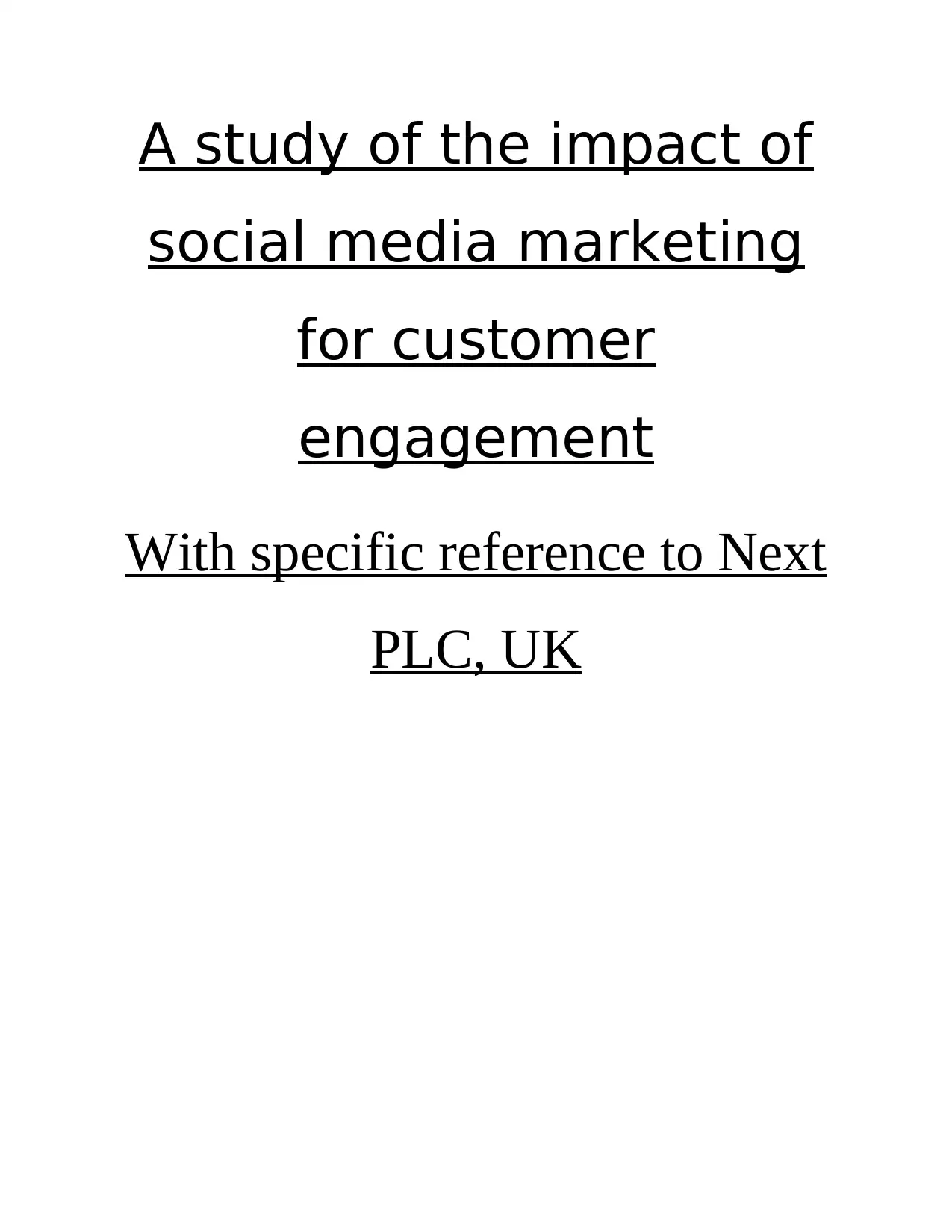
A study of the impact of
social media marketing
for customer
engagement
With specific reference to Next
PLC, UK
social media marketing
for customer
engagement
With specific reference to Next
PLC, UK
Paraphrase This Document
Need a fresh take? Get an instant paraphrase of this document with our AI Paraphraser

Acknowledgement
This research study has been an extraordinary journey that ended one chapter in my life,
only to begin another. This journey could never have been completed without the kind and
support of my family, friend and relatives. I would like to dedicate a special thanks to my mentor
who guided me throughout this thesis.
This research study has been an extraordinary journey that ended one chapter in my life,
only to begin another. This journey could never have been completed without the kind and
support of my family, friend and relatives. I would like to dedicate a special thanks to my mentor
who guided me throughout this thesis.
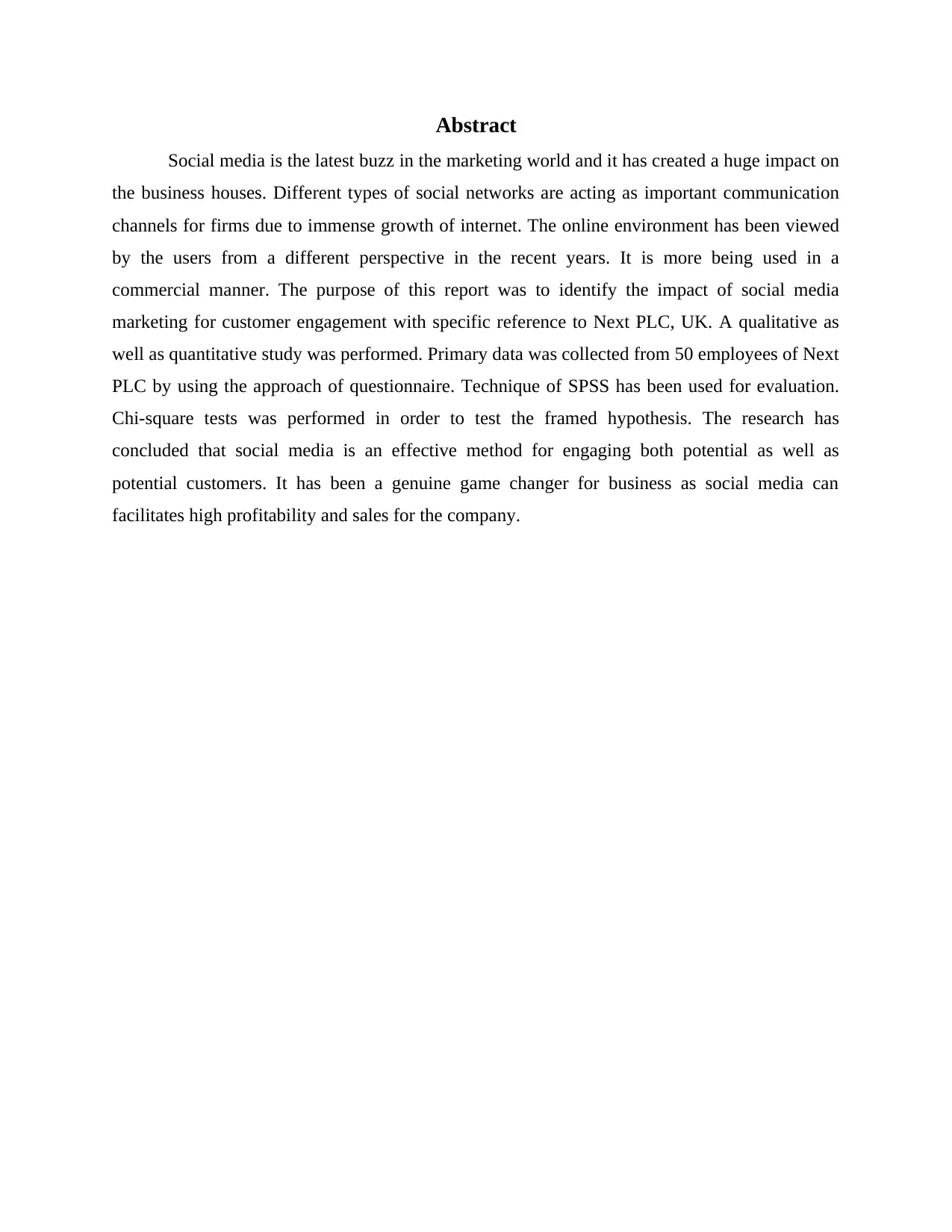
Abstract
Social media is the latest buzz in the marketing world and it has created a huge impact on
the business houses. Different types of social networks are acting as important communication
channels for firms due to immense growth of internet. The online environment has been viewed
by the users from a different perspective in the recent years. It is more being used in a
commercial manner. The purpose of this report was to identify the impact of social media
marketing for customer engagement with specific reference to Next PLC, UK. A qualitative as
well as quantitative study was performed. Primary data was collected from 50 employees of Next
PLC by using the approach of questionnaire. Technique of SPSS has been used for evaluation.
Chi-square tests was performed in order to test the framed hypothesis. The research has
concluded that social media is an effective method for engaging both potential as well as
potential customers. It has been a genuine game changer for business as social media can
facilitates high profitability and sales for the company.
Social media is the latest buzz in the marketing world and it has created a huge impact on
the business houses. Different types of social networks are acting as important communication
channels for firms due to immense growth of internet. The online environment has been viewed
by the users from a different perspective in the recent years. It is more being used in a
commercial manner. The purpose of this report was to identify the impact of social media
marketing for customer engagement with specific reference to Next PLC, UK. A qualitative as
well as quantitative study was performed. Primary data was collected from 50 employees of Next
PLC by using the approach of questionnaire. Technique of SPSS has been used for evaluation.
Chi-square tests was performed in order to test the framed hypothesis. The research has
concluded that social media is an effective method for engaging both potential as well as
potential customers. It has been a genuine game changer for business as social media can
facilitates high profitability and sales for the company.
⊘ This is a preview!⊘
Do you want full access?
Subscribe today to unlock all pages.

Trusted by 1+ million students worldwide
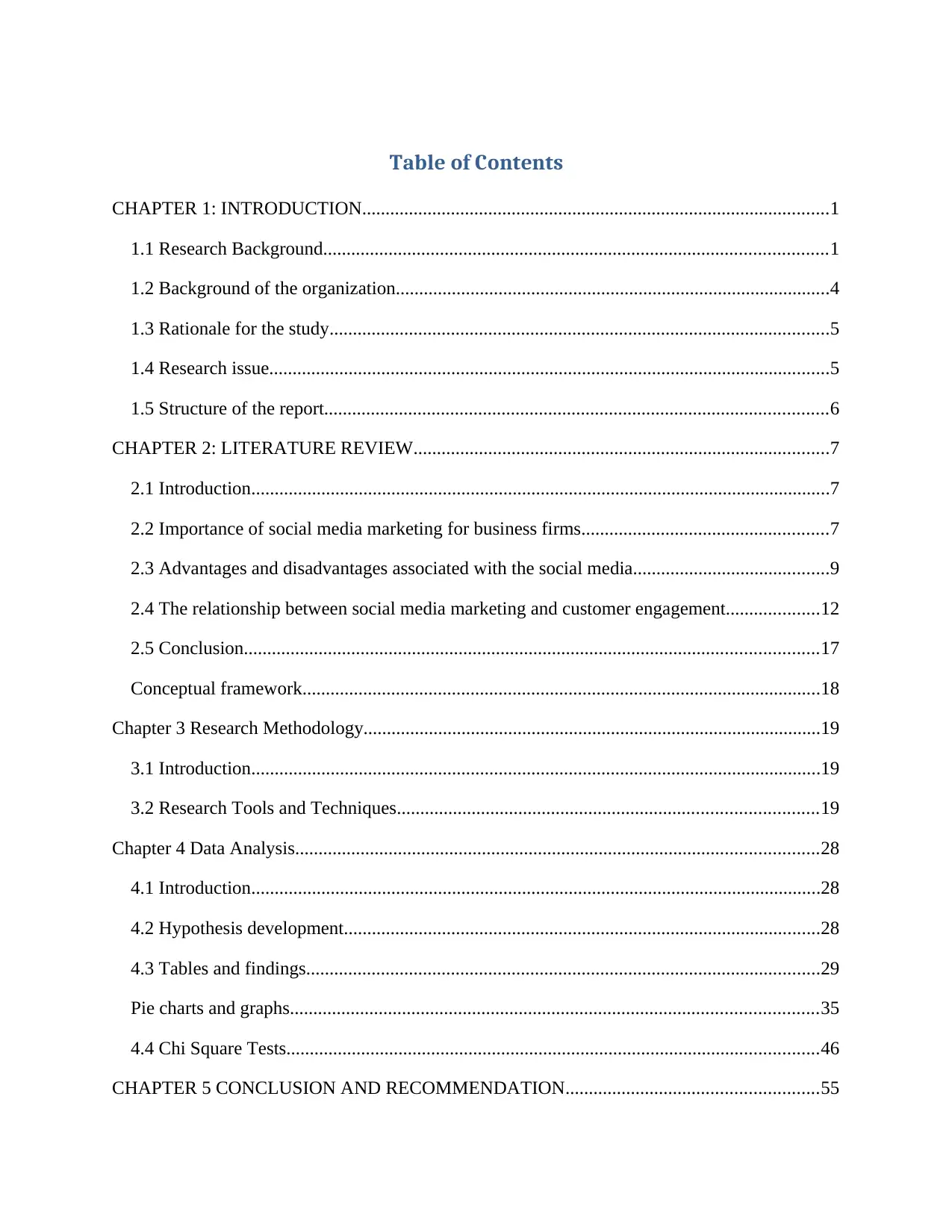
Table of Contents
CHAPTER 1: INTRODUCTION....................................................................................................1
1.1 Research Background............................................................................................................1
1.2 Background of the organization.............................................................................................4
1.3 Rationale for the study...........................................................................................................5
1.4 Research issue........................................................................................................................5
1.5 Structure of the report............................................................................................................6
CHAPTER 2: LITERATURE REVIEW.........................................................................................7
2.1 Introduction............................................................................................................................7
2.2 Importance of social media marketing for business firms.....................................................7
2.3 Advantages and disadvantages associated with the social media..........................................9
2.4 The relationship between social media marketing and customer engagement....................12
2.5 Conclusion...........................................................................................................................17
Conceptual framework...............................................................................................................18
Chapter 3 Research Methodology..................................................................................................19
3.1 Introduction..........................................................................................................................19
3.2 Research Tools and Techniques..........................................................................................19
Chapter 4 Data Analysis................................................................................................................28
4.1 Introduction..........................................................................................................................28
4.2 Hypothesis development......................................................................................................28
4.3 Tables and findings..............................................................................................................29
Pie charts and graphs.................................................................................................................35
4.4 Chi Square Tests..................................................................................................................46
CHAPTER 5 CONCLUSION AND RECOMMENDATION......................................................55
CHAPTER 1: INTRODUCTION....................................................................................................1
1.1 Research Background............................................................................................................1
1.2 Background of the organization.............................................................................................4
1.3 Rationale for the study...........................................................................................................5
1.4 Research issue........................................................................................................................5
1.5 Structure of the report............................................................................................................6
CHAPTER 2: LITERATURE REVIEW.........................................................................................7
2.1 Introduction............................................................................................................................7
2.2 Importance of social media marketing for business firms.....................................................7
2.3 Advantages and disadvantages associated with the social media..........................................9
2.4 The relationship between social media marketing and customer engagement....................12
2.5 Conclusion...........................................................................................................................17
Conceptual framework...............................................................................................................18
Chapter 3 Research Methodology..................................................................................................19
3.1 Introduction..........................................................................................................................19
3.2 Research Tools and Techniques..........................................................................................19
Chapter 4 Data Analysis................................................................................................................28
4.1 Introduction..........................................................................................................................28
4.2 Hypothesis development......................................................................................................28
4.3 Tables and findings..............................................................................................................29
Pie charts and graphs.................................................................................................................35
4.4 Chi Square Tests..................................................................................................................46
CHAPTER 5 CONCLUSION AND RECOMMENDATION......................................................55
Paraphrase This Document
Need a fresh take? Get an instant paraphrase of this document with our AI Paraphraser
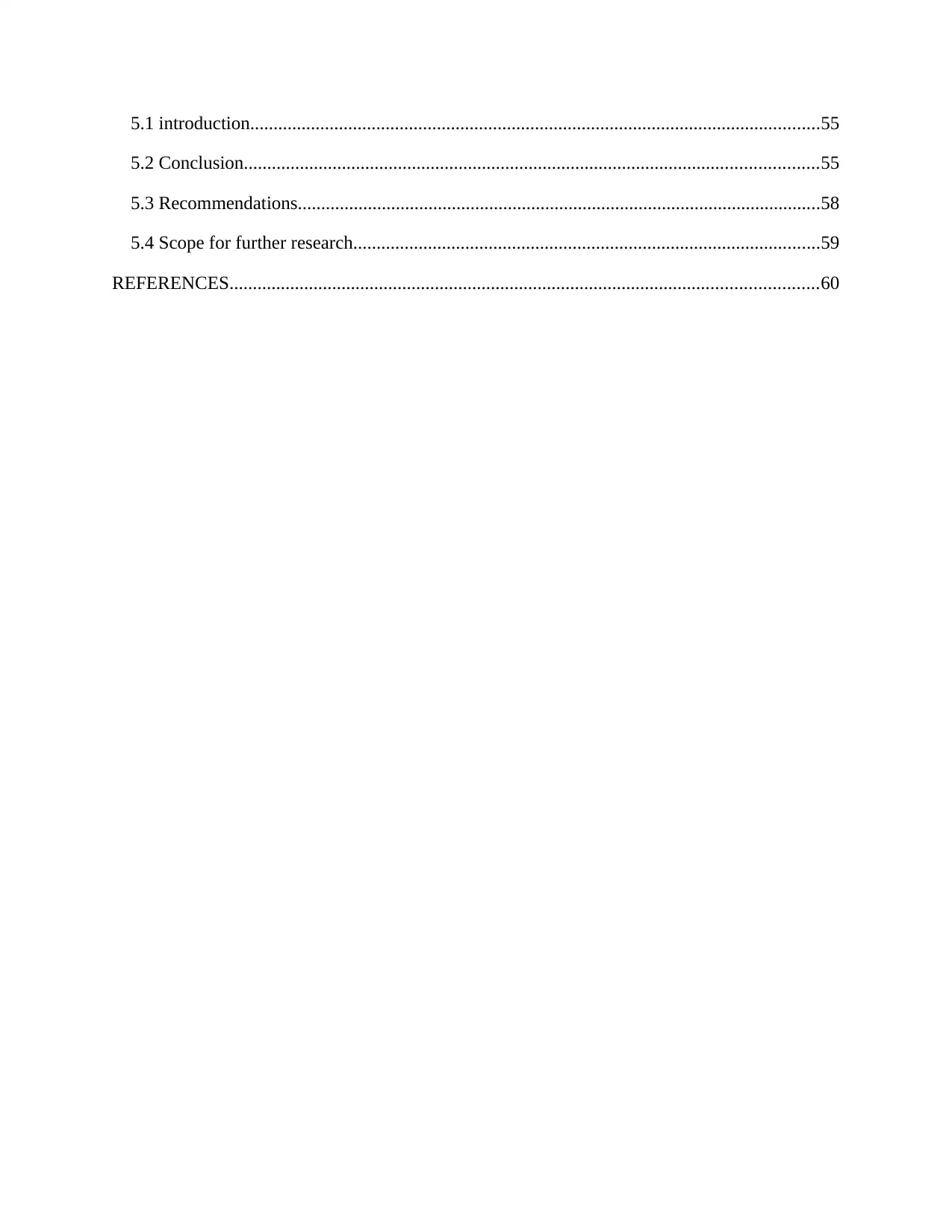
5.1 introduction..........................................................................................................................55
5.2 Conclusion...........................................................................................................................55
5.3 Recommendations................................................................................................................58
5.4 Scope for further research....................................................................................................59
REFERENCES..............................................................................................................................60
5.2 Conclusion...........................................................................................................................55
5.3 Recommendations................................................................................................................58
5.4 Scope for further research....................................................................................................59
REFERENCES..............................................................................................................................60
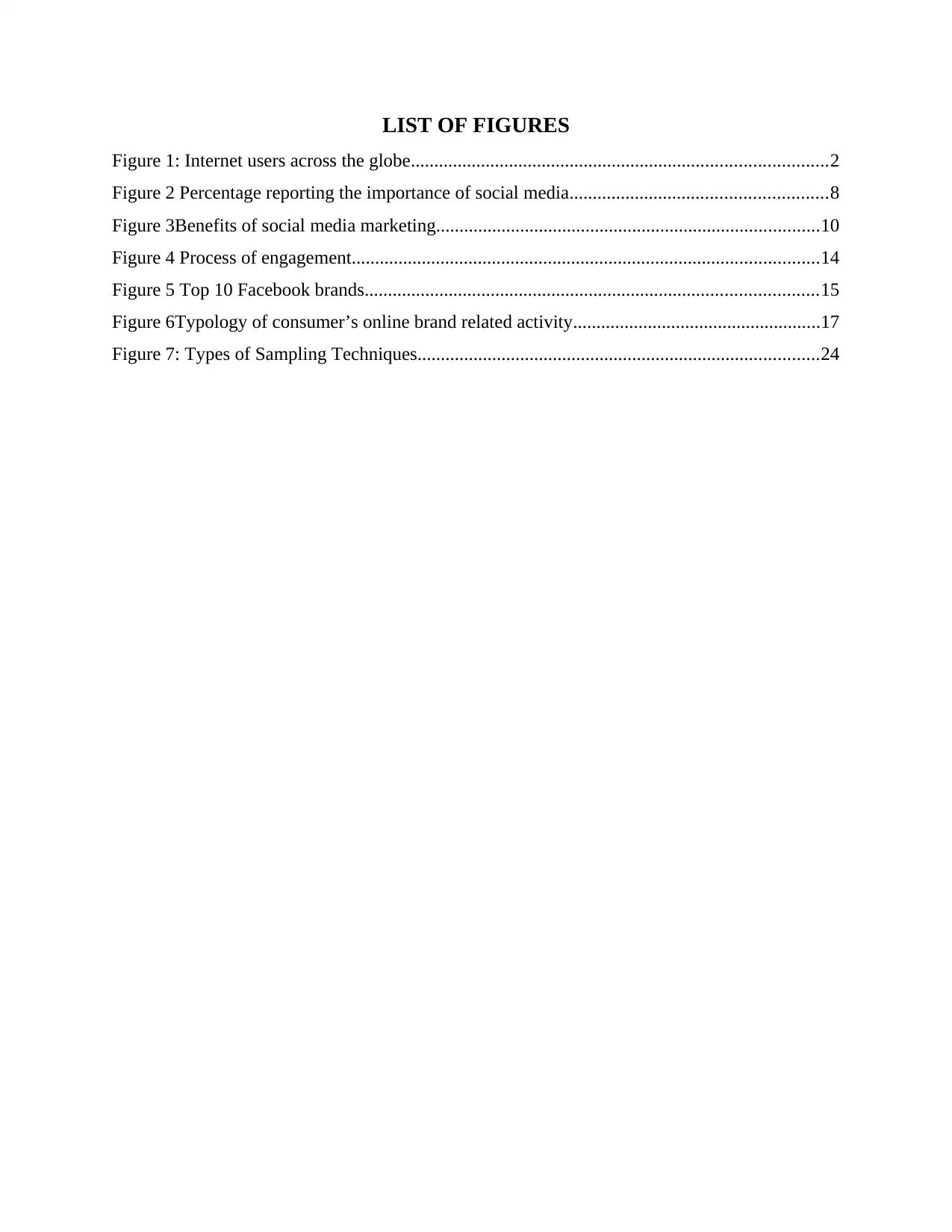
LIST OF FIGURES
Figure 1: Internet users across the globe.........................................................................................2
Figure 2 Percentage reporting the importance of social media.......................................................8
Figure 3Benefits of social media marketing..................................................................................10
Figure 4 Process of engagement....................................................................................................14
Figure 5 Top 10 Facebook brands.................................................................................................15
Figure 6Typology of consumer’s online brand related activity.....................................................17
Figure 7: Types of Sampling Techniques......................................................................................24
Figure 1: Internet users across the globe.........................................................................................2
Figure 2 Percentage reporting the importance of social media.......................................................8
Figure 3Benefits of social media marketing..................................................................................10
Figure 4 Process of engagement....................................................................................................14
Figure 5 Top 10 Facebook brands.................................................................................................15
Figure 6Typology of consumer’s online brand related activity.....................................................17
Figure 7: Types of Sampling Techniques......................................................................................24
⊘ This is a preview!⊘
Do you want full access?
Subscribe today to unlock all pages.

Trusted by 1+ million students worldwide
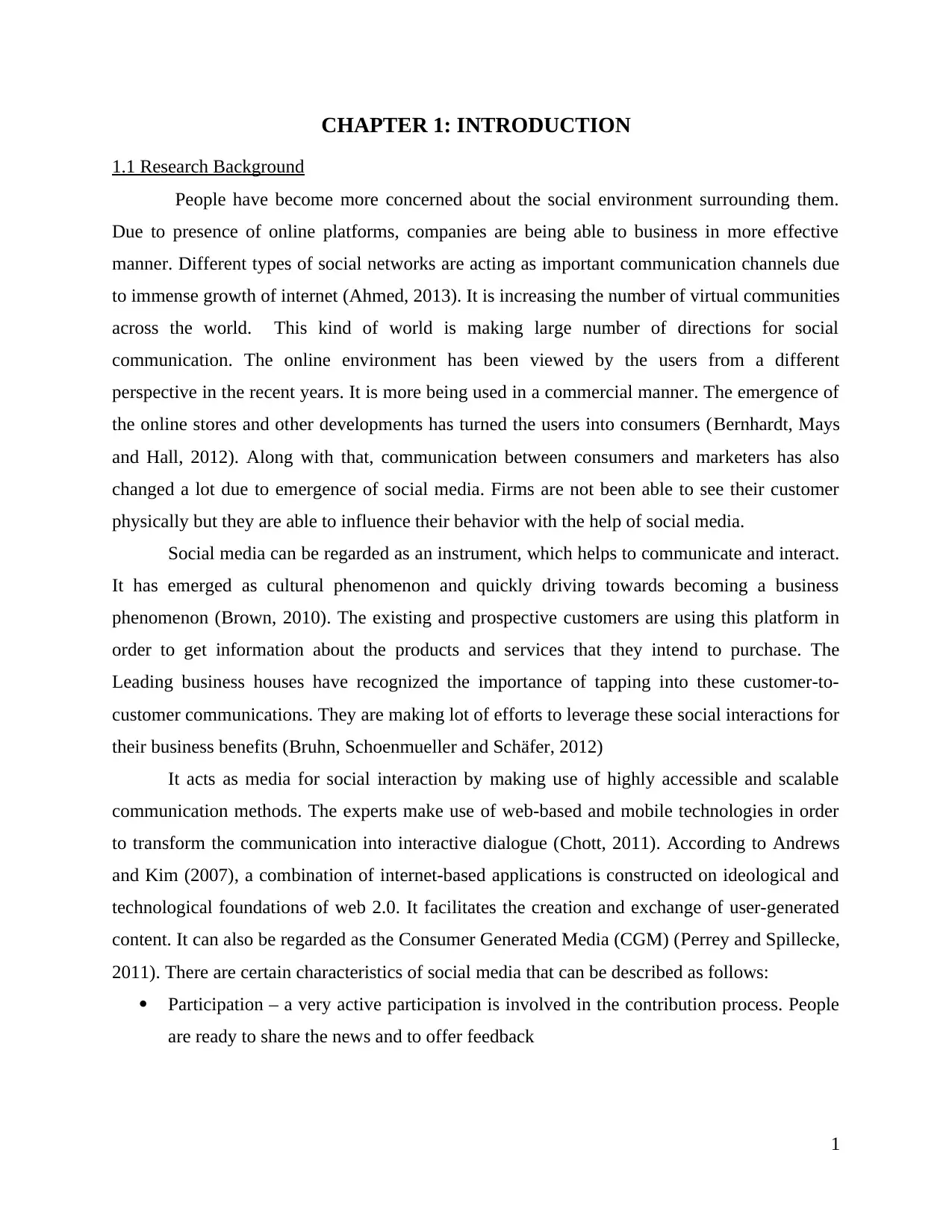
CHAPTER 1: INTRODUCTION
1.1 Research Background
People have become more concerned about the social environment surrounding them.
Due to presence of online platforms, companies are being able to business in more effective
manner. Different types of social networks are acting as important communication channels due
to immense growth of internet (Ahmed, 2013). It is increasing the number of virtual communities
across the world. This kind of world is making large number of directions for social
communication. The online environment has been viewed by the users from a different
perspective in the recent years. It is more being used in a commercial manner. The emergence of
the online stores and other developments has turned the users into consumers (Bernhardt, Mays
and Hall, 2012). Along with that, communication between consumers and marketers has also
changed a lot due to emergence of social media. Firms are not been able to see their customer
physically but they are able to influence their behavior with the help of social media.
Social media can be regarded as an instrument, which helps to communicate and interact.
It has emerged as cultural phenomenon and quickly driving towards becoming a business
phenomenon (Brown, 2010). The existing and prospective customers are using this platform in
order to get information about the products and services that they intend to purchase. The
Leading business houses have recognized the importance of tapping into these customer-to-
customer communications. They are making lot of efforts to leverage these social interactions for
their business benefits (Bruhn, Schoenmueller and Schäfer, 2012)
It acts as media for social interaction by making use of highly accessible and scalable
communication methods. The experts make use of web-based and mobile technologies in order
to transform the communication into interactive dialogue (Chott, 2011). According to Andrews
and Kim (2007), a combination of internet-based applications is constructed on ideological and
technological foundations of web 2.0. It facilitates the creation and exchange of user-generated
content. It can also be regarded as the Consumer Generated Media (CGM) (Perrey and Spillecke,
2011). There are certain characteristics of social media that can be described as follows:
Participation – a very active participation is involved in the contribution process. People
are ready to share the news and to offer feedback
1
1.1 Research Background
People have become more concerned about the social environment surrounding them.
Due to presence of online platforms, companies are being able to business in more effective
manner. Different types of social networks are acting as important communication channels due
to immense growth of internet (Ahmed, 2013). It is increasing the number of virtual communities
across the world. This kind of world is making large number of directions for social
communication. The online environment has been viewed by the users from a different
perspective in the recent years. It is more being used in a commercial manner. The emergence of
the online stores and other developments has turned the users into consumers (Bernhardt, Mays
and Hall, 2012). Along with that, communication between consumers and marketers has also
changed a lot due to emergence of social media. Firms are not been able to see their customer
physically but they are able to influence their behavior with the help of social media.
Social media can be regarded as an instrument, which helps to communicate and interact.
It has emerged as cultural phenomenon and quickly driving towards becoming a business
phenomenon (Brown, 2010). The existing and prospective customers are using this platform in
order to get information about the products and services that they intend to purchase. The
Leading business houses have recognized the importance of tapping into these customer-to-
customer communications. They are making lot of efforts to leverage these social interactions for
their business benefits (Bruhn, Schoenmueller and Schäfer, 2012)
It acts as media for social interaction by making use of highly accessible and scalable
communication methods. The experts make use of web-based and mobile technologies in order
to transform the communication into interactive dialogue (Chott, 2011). According to Andrews
and Kim (2007), a combination of internet-based applications is constructed on ideological and
technological foundations of web 2.0. It facilitates the creation and exchange of user-generated
content. It can also be regarded as the Consumer Generated Media (CGM) (Perrey and Spillecke,
2011). There are certain characteristics of social media that can be described as follows:
Participation – a very active participation is involved in the contribution process. People
are ready to share the news and to offer feedback
1
Paraphrase This Document
Need a fresh take? Get an instant paraphrase of this document with our AI Paraphraser
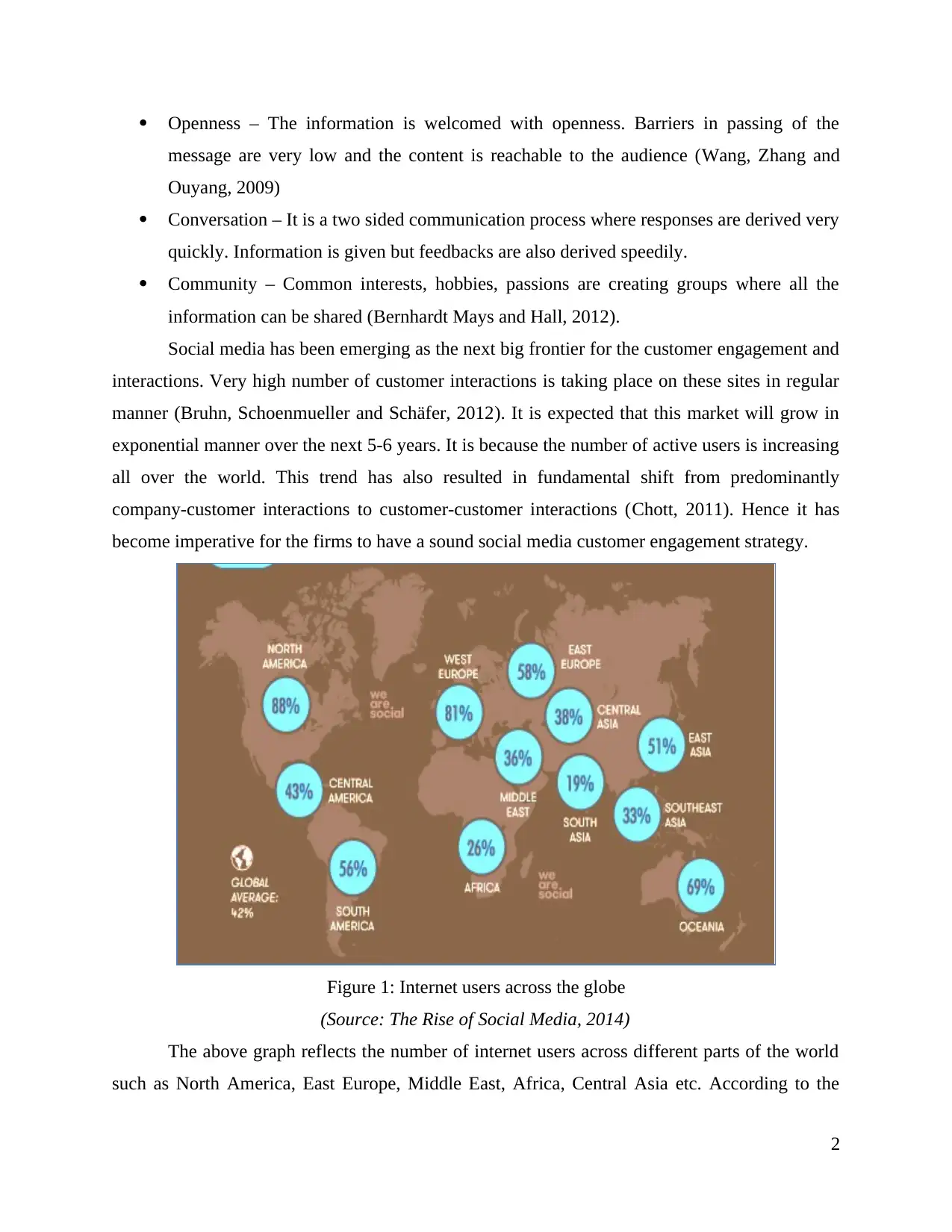
Openness – The information is welcomed with openness. Barriers in passing of the
message are very low and the content is reachable to the audience (Wang, Zhang and
Ouyang, 2009)
Conversation – It is a two sided communication process where responses are derived very
quickly. Information is given but feedbacks are also derived speedily.
Community – Common interests, hobbies, passions are creating groups where all the
information can be shared (Bernhardt Mays and Hall, 2012).
Social media has been emerging as the next big frontier for the customer engagement and
interactions. Very high number of customer interactions is taking place on these sites in regular
manner (Bruhn, Schoenmueller and Schäfer, 2012). It is expected that this market will grow in
exponential manner over the next 5-6 years. It is because the number of active users is increasing
all over the world. This trend has also resulted in fundamental shift from predominantly
company-customer interactions to customer-customer interactions (Chott, 2011). Hence it has
become imperative for the firms to have a sound social media customer engagement strategy.
Figure 1: Internet users across the globe
(Source: The Rise of Social Media, 2014)
The above graph reflects the number of internet users across different parts of the world
such as North America, East Europe, Middle East, Africa, Central Asia etc. According to the
2
message are very low and the content is reachable to the audience (Wang, Zhang and
Ouyang, 2009)
Conversation – It is a two sided communication process where responses are derived very
quickly. Information is given but feedbacks are also derived speedily.
Community – Common interests, hobbies, passions are creating groups where all the
information can be shared (Bernhardt Mays and Hall, 2012).
Social media has been emerging as the next big frontier for the customer engagement and
interactions. Very high number of customer interactions is taking place on these sites in regular
manner (Bruhn, Schoenmueller and Schäfer, 2012). It is expected that this market will grow in
exponential manner over the next 5-6 years. It is because the number of active users is increasing
all over the world. This trend has also resulted in fundamental shift from predominantly
company-customer interactions to customer-customer interactions (Chott, 2011). Hence it has
become imperative for the firms to have a sound social media customer engagement strategy.
Figure 1: Internet users across the globe
(Source: The Rise of Social Media, 2014)
The above graph reflects the number of internet users across different parts of the world
such as North America, East Europe, Middle East, Africa, Central Asia etc. According to the
2
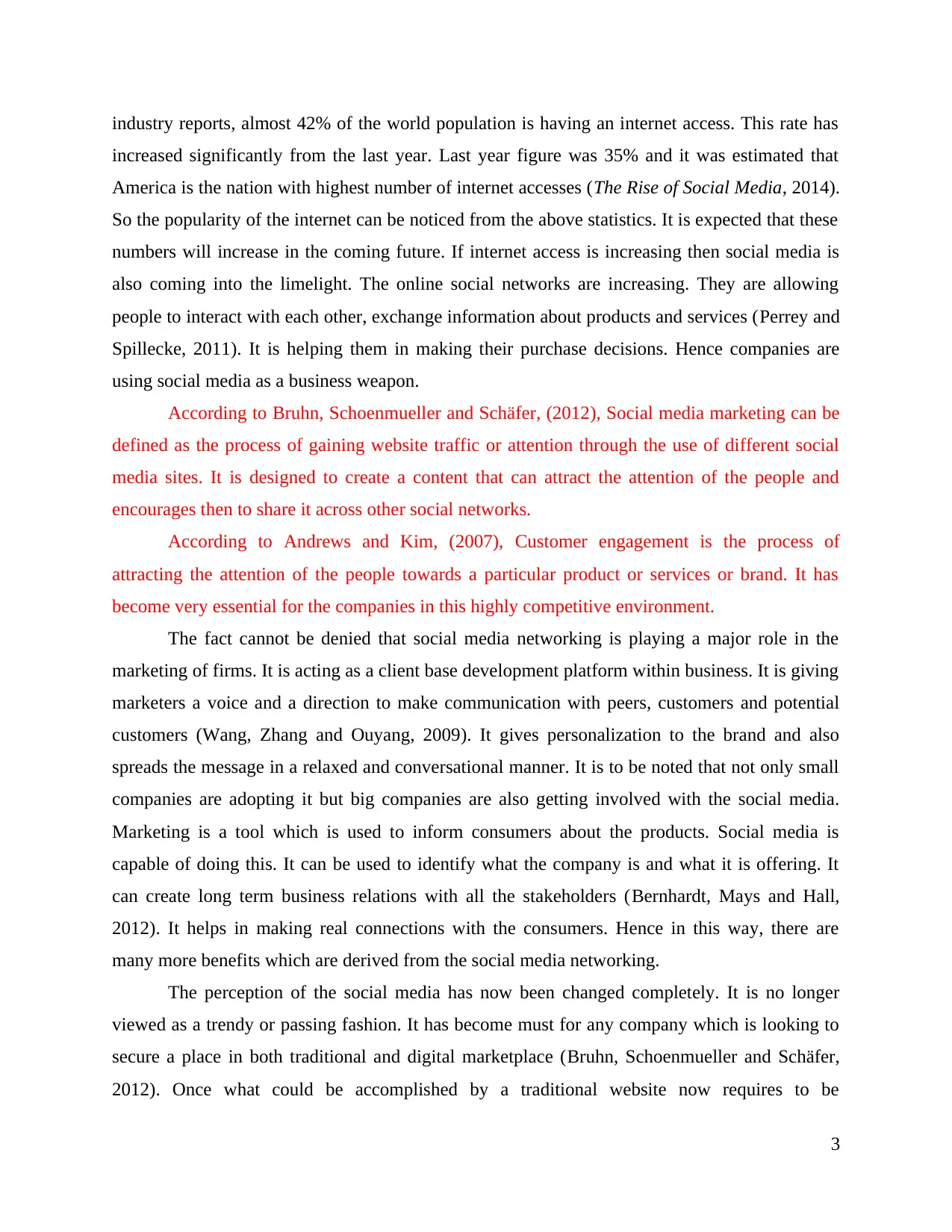
industry reports, almost 42% of the world population is having an internet access. This rate has
increased significantly from the last year. Last year figure was 35% and it was estimated that
America is the nation with highest number of internet accesses (The Rise of Social Media, 2014).
So the popularity of the internet can be noticed from the above statistics. It is expected that these
numbers will increase in the coming future. If internet access is increasing then social media is
also coming into the limelight. The online social networks are increasing. They are allowing
people to interact with each other, exchange information about products and services (Perrey and
Spillecke, 2011). It is helping them in making their purchase decisions. Hence companies are
using social media as a business weapon.
According to Bruhn, Schoenmueller and Schäfer, (2012), Social media marketing can be
defined as the process of gaining website traffic or attention through the use of different social
media sites. It is designed to create a content that can attract the attention of the people and
encourages then to share it across other social networks.
According to Andrews and Kim, (2007), Customer engagement is the process of
attracting the attention of the people towards a particular product or services or brand. It has
become very essential for the companies in this highly competitive environment.
The fact cannot be denied that social media networking is playing a major role in the
marketing of firms. It is acting as a client base development platform within business. It is giving
marketers a voice and a direction to make communication with peers, customers and potential
customers (Wang, Zhang and Ouyang, 2009). It gives personalization to the brand and also
spreads the message in a relaxed and conversational manner. It is to be noted that not only small
companies are adopting it but big companies are also getting involved with the social media.
Marketing is a tool which is used to inform consumers about the products. Social media is
capable of doing this. It can be used to identify what the company is and what it is offering. It
can create long term business relations with all the stakeholders (Bernhardt, Mays and Hall,
2012). It helps in making real connections with the consumers. Hence in this way, there are
many more benefits which are derived from the social media networking.
The perception of the social media has now been changed completely. It is no longer
viewed as a trendy or passing fashion. It has become must for any company which is looking to
secure a place in both traditional and digital marketplace (Bruhn, Schoenmueller and Schäfer,
2012). Once what could be accomplished by a traditional website now requires to be
3
increased significantly from the last year. Last year figure was 35% and it was estimated that
America is the nation with highest number of internet accesses (The Rise of Social Media, 2014).
So the popularity of the internet can be noticed from the above statistics. It is expected that these
numbers will increase in the coming future. If internet access is increasing then social media is
also coming into the limelight. The online social networks are increasing. They are allowing
people to interact with each other, exchange information about products and services (Perrey and
Spillecke, 2011). It is helping them in making their purchase decisions. Hence companies are
using social media as a business weapon.
According to Bruhn, Schoenmueller and Schäfer, (2012), Social media marketing can be
defined as the process of gaining website traffic or attention through the use of different social
media sites. It is designed to create a content that can attract the attention of the people and
encourages then to share it across other social networks.
According to Andrews and Kim, (2007), Customer engagement is the process of
attracting the attention of the people towards a particular product or services or brand. It has
become very essential for the companies in this highly competitive environment.
The fact cannot be denied that social media networking is playing a major role in the
marketing of firms. It is acting as a client base development platform within business. It is giving
marketers a voice and a direction to make communication with peers, customers and potential
customers (Wang, Zhang and Ouyang, 2009). It gives personalization to the brand and also
spreads the message in a relaxed and conversational manner. It is to be noted that not only small
companies are adopting it but big companies are also getting involved with the social media.
Marketing is a tool which is used to inform consumers about the products. Social media is
capable of doing this. It can be used to identify what the company is and what it is offering. It
can create long term business relations with all the stakeholders (Bernhardt, Mays and Hall,
2012). It helps in making real connections with the consumers. Hence in this way, there are
many more benefits which are derived from the social media networking.
The perception of the social media has now been changed completely. It is no longer
viewed as a trendy or passing fashion. It has become must for any company which is looking to
secure a place in both traditional and digital marketplace (Bruhn, Schoenmueller and Schäfer,
2012). Once what could be accomplished by a traditional website now requires to be
3
⊘ This is a preview!⊘
Do you want full access?
Subscribe today to unlock all pages.

Trusted by 1+ million students worldwide
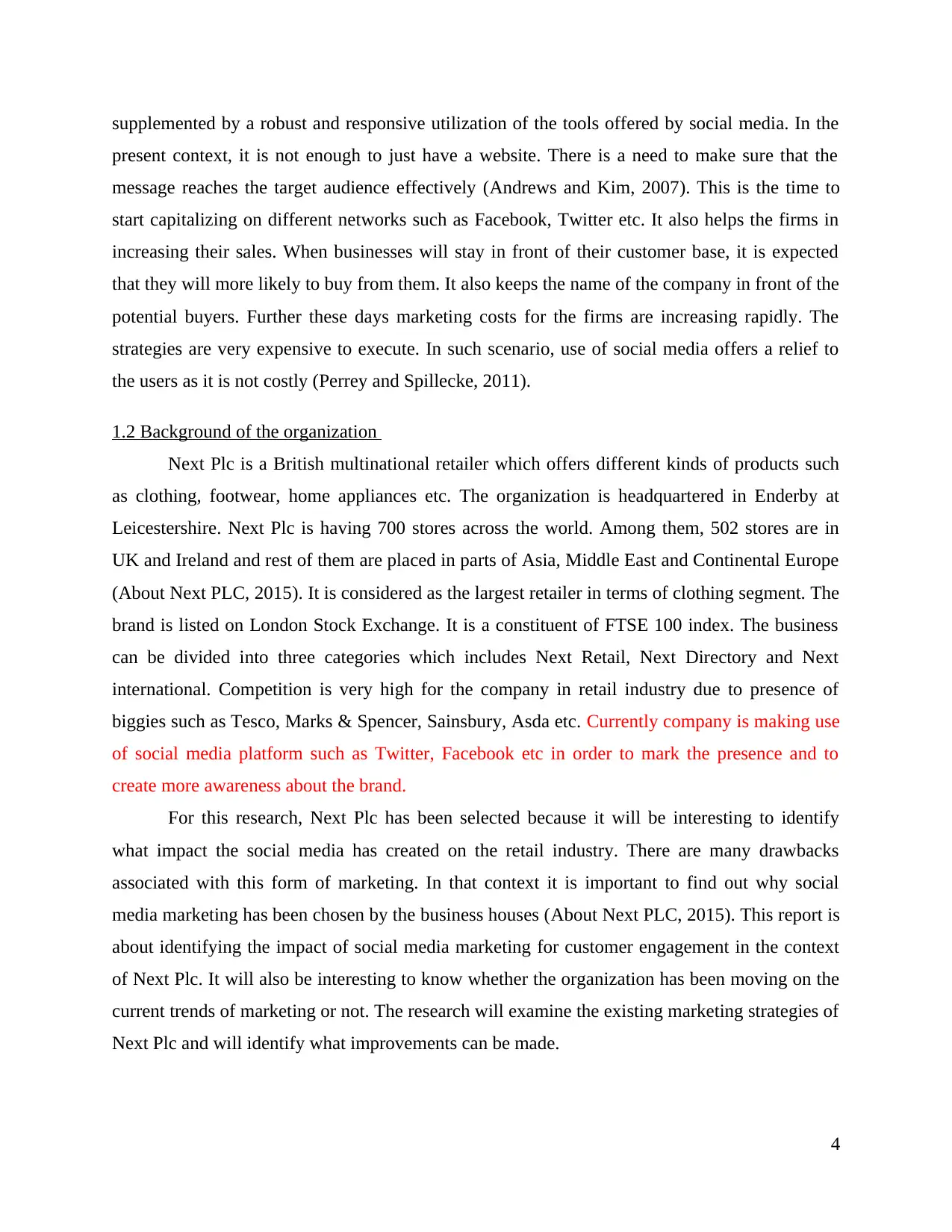
supplemented by a robust and responsive utilization of the tools offered by social media. In the
present context, it is not enough to just have a website. There is a need to make sure that the
message reaches the target audience effectively (Andrews and Kim, 2007). This is the time to
start capitalizing on different networks such as Facebook, Twitter etc. It also helps the firms in
increasing their sales. When businesses will stay in front of their customer base, it is expected
that they will more likely to buy from them. It also keeps the name of the company in front of the
potential buyers. Further these days marketing costs for the firms are increasing rapidly. The
strategies are very expensive to execute. In such scenario, use of social media offers a relief to
the users as it is not costly (Perrey and Spillecke, 2011).
1.2 Background of the organization
Next Plc is a British multinational retailer which offers different kinds of products such
as clothing, footwear, home appliances etc. The organization is headquartered in Enderby at
Leicestershire. Next Plc is having 700 stores across the world. Among them, 502 stores are in
UK and Ireland and rest of them are placed in parts of Asia, Middle East and Continental Europe
(About Next PLC, 2015). It is considered as the largest retailer in terms of clothing segment. The
brand is listed on London Stock Exchange. It is a constituent of FTSE 100 index. The business
can be divided into three categories which includes Next Retail, Next Directory and Next
international. Competition is very high for the company in retail industry due to presence of
biggies such as Tesco, Marks & Spencer, Sainsbury, Asda etc. Currently company is making use
of social media platform such as Twitter, Facebook etc in order to mark the presence and to
create more awareness about the brand.
For this research, Next Plc has been selected because it will be interesting to identify
what impact the social media has created on the retail industry. There are many drawbacks
associated with this form of marketing. In that context it is important to find out why social
media marketing has been chosen by the business houses (About Next PLC, 2015). This report is
about identifying the impact of social media marketing for customer engagement in the context
of Next Plc. It will also be interesting to know whether the organization has been moving on the
current trends of marketing or not. The research will examine the existing marketing strategies of
Next Plc and will identify what improvements can be made.
4
present context, it is not enough to just have a website. There is a need to make sure that the
message reaches the target audience effectively (Andrews and Kim, 2007). This is the time to
start capitalizing on different networks such as Facebook, Twitter etc. It also helps the firms in
increasing their sales. When businesses will stay in front of their customer base, it is expected
that they will more likely to buy from them. It also keeps the name of the company in front of the
potential buyers. Further these days marketing costs for the firms are increasing rapidly. The
strategies are very expensive to execute. In such scenario, use of social media offers a relief to
the users as it is not costly (Perrey and Spillecke, 2011).
1.2 Background of the organization
Next Plc is a British multinational retailer which offers different kinds of products such
as clothing, footwear, home appliances etc. The organization is headquartered in Enderby at
Leicestershire. Next Plc is having 700 stores across the world. Among them, 502 stores are in
UK and Ireland and rest of them are placed in parts of Asia, Middle East and Continental Europe
(About Next PLC, 2015). It is considered as the largest retailer in terms of clothing segment. The
brand is listed on London Stock Exchange. It is a constituent of FTSE 100 index. The business
can be divided into three categories which includes Next Retail, Next Directory and Next
international. Competition is very high for the company in retail industry due to presence of
biggies such as Tesco, Marks & Spencer, Sainsbury, Asda etc. Currently company is making use
of social media platform such as Twitter, Facebook etc in order to mark the presence and to
create more awareness about the brand.
For this research, Next Plc has been selected because it will be interesting to identify
what impact the social media has created on the retail industry. There are many drawbacks
associated with this form of marketing. In that context it is important to find out why social
media marketing has been chosen by the business houses (About Next PLC, 2015). This report is
about identifying the impact of social media marketing for customer engagement in the context
of Next Plc. It will also be interesting to know whether the organization has been moving on the
current trends of marketing or not. The research will examine the existing marketing strategies of
Next Plc and will identify what improvements can be made.
4
Paraphrase This Document
Need a fresh take? Get an instant paraphrase of this document with our AI Paraphraser
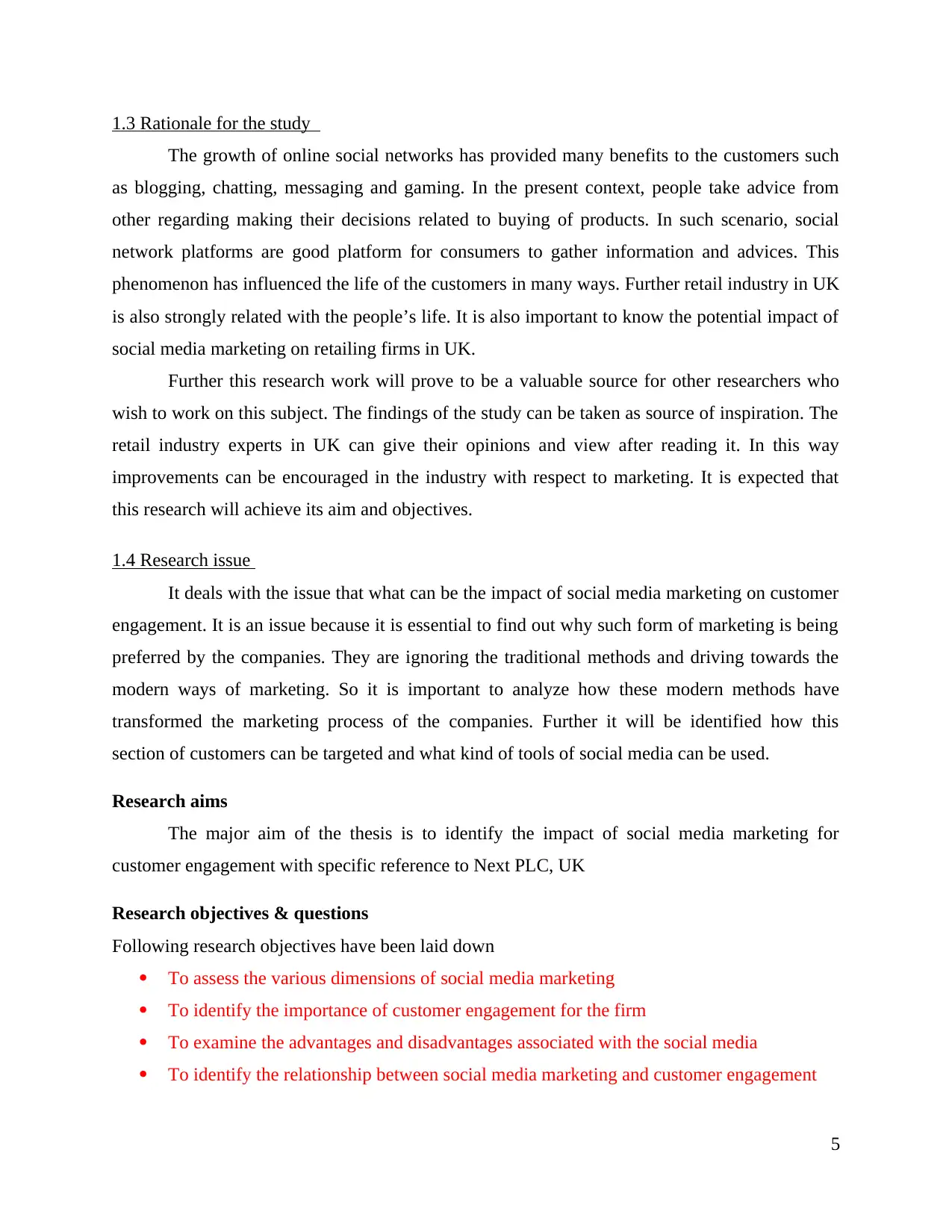
1.3 Rationale for the study
The growth of online social networks has provided many benefits to the customers such
as blogging, chatting, messaging and gaming. In the present context, people take advice from
other regarding making their decisions related to buying of products. In such scenario, social
network platforms are good platform for consumers to gather information and advices. This
phenomenon has influenced the life of the customers in many ways. Further retail industry in UK
is also strongly related with the people’s life. It is also important to know the potential impact of
social media marketing on retailing firms in UK.
Further this research work will prove to be a valuable source for other researchers who
wish to work on this subject. The findings of the study can be taken as source of inspiration. The
retail industry experts in UK can give their opinions and view after reading it. In this way
improvements can be encouraged in the industry with respect to marketing. It is expected that
this research will achieve its aim and objectives.
1.4 Research issue
It deals with the issue that what can be the impact of social media marketing on customer
engagement. It is an issue because it is essential to find out why such form of marketing is being
preferred by the companies. They are ignoring the traditional methods and driving towards the
modern ways of marketing. So it is important to analyze how these modern methods have
transformed the marketing process of the companies. Further it will be identified how this
section of customers can be targeted and what kind of tools of social media can be used.
Research aims
The major aim of the thesis is to identify the impact of social media marketing for
customer engagement with specific reference to Next PLC, UK
Research objectives & questions
Following research objectives have been laid down
To assess the various dimensions of social media marketing
To identify the importance of customer engagement for the firm
To examine the advantages and disadvantages associated with the social media
To identify the relationship between social media marketing and customer engagement
5
The growth of online social networks has provided many benefits to the customers such
as blogging, chatting, messaging and gaming. In the present context, people take advice from
other regarding making their decisions related to buying of products. In such scenario, social
network platforms are good platform for consumers to gather information and advices. This
phenomenon has influenced the life of the customers in many ways. Further retail industry in UK
is also strongly related with the people’s life. It is also important to know the potential impact of
social media marketing on retailing firms in UK.
Further this research work will prove to be a valuable source for other researchers who
wish to work on this subject. The findings of the study can be taken as source of inspiration. The
retail industry experts in UK can give their opinions and view after reading it. In this way
improvements can be encouraged in the industry with respect to marketing. It is expected that
this research will achieve its aim and objectives.
1.4 Research issue
It deals with the issue that what can be the impact of social media marketing on customer
engagement. It is an issue because it is essential to find out why such form of marketing is being
preferred by the companies. They are ignoring the traditional methods and driving towards the
modern ways of marketing. So it is important to analyze how these modern methods have
transformed the marketing process of the companies. Further it will be identified how this
section of customers can be targeted and what kind of tools of social media can be used.
Research aims
The major aim of the thesis is to identify the impact of social media marketing for
customer engagement with specific reference to Next PLC, UK
Research objectives & questions
Following research objectives have been laid down
To assess the various dimensions of social media marketing
To identify the importance of customer engagement for the firm
To examine the advantages and disadvantages associated with the social media
To identify the relationship between social media marketing and customer engagement
5
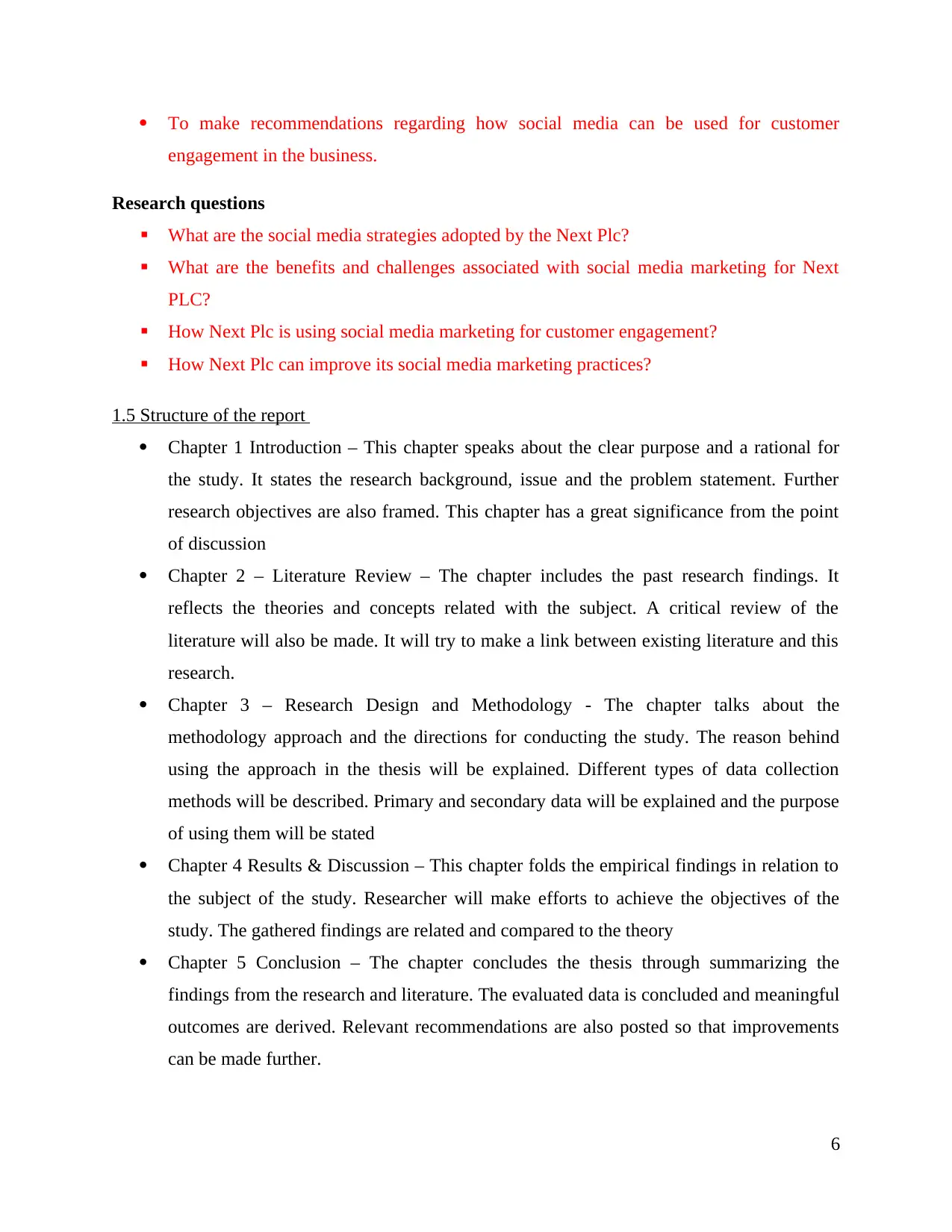
To make recommendations regarding how social media can be used for customer
engagement in the business.
Research questions
What are the social media strategies adopted by the Next Plc?
What are the benefits and challenges associated with social media marketing for Next
PLC?
How Next Plc is using social media marketing for customer engagement?
How Next Plc can improve its social media marketing practices?
1.5 Structure of the report
Chapter 1 Introduction – This chapter speaks about the clear purpose and a rational for
the study. It states the research background, issue and the problem statement. Further
research objectives are also framed. This chapter has a great significance from the point
of discussion
Chapter 2 – Literature Review – The chapter includes the past research findings. It
reflects the theories and concepts related with the subject. A critical review of the
literature will also be made. It will try to make a link between existing literature and this
research.
Chapter 3 – Research Design and Methodology - The chapter talks about the
methodology approach and the directions for conducting the study. The reason behind
using the approach in the thesis will be explained. Different types of data collection
methods will be described. Primary and secondary data will be explained and the purpose
of using them will be stated
Chapter 4 Results & Discussion – This chapter folds the empirical findings in relation to
the subject of the study. Researcher will make efforts to achieve the objectives of the
study. The gathered findings are related and compared to the theory
Chapter 5 Conclusion – The chapter concludes the thesis through summarizing the
findings from the research and literature. The evaluated data is concluded and meaningful
outcomes are derived. Relevant recommendations are also posted so that improvements
can be made further.
6
engagement in the business.
Research questions
What are the social media strategies adopted by the Next Plc?
What are the benefits and challenges associated with social media marketing for Next
PLC?
How Next Plc is using social media marketing for customer engagement?
How Next Plc can improve its social media marketing practices?
1.5 Structure of the report
Chapter 1 Introduction – This chapter speaks about the clear purpose and a rational for
the study. It states the research background, issue and the problem statement. Further
research objectives are also framed. This chapter has a great significance from the point
of discussion
Chapter 2 – Literature Review – The chapter includes the past research findings. It
reflects the theories and concepts related with the subject. A critical review of the
literature will also be made. It will try to make a link between existing literature and this
research.
Chapter 3 – Research Design and Methodology - The chapter talks about the
methodology approach and the directions for conducting the study. The reason behind
using the approach in the thesis will be explained. Different types of data collection
methods will be described. Primary and secondary data will be explained and the purpose
of using them will be stated
Chapter 4 Results & Discussion – This chapter folds the empirical findings in relation to
the subject of the study. Researcher will make efforts to achieve the objectives of the
study. The gathered findings are related and compared to the theory
Chapter 5 Conclusion – The chapter concludes the thesis through summarizing the
findings from the research and literature. The evaluated data is concluded and meaningful
outcomes are derived. Relevant recommendations are also posted so that improvements
can be made further.
6
⊘ This is a preview!⊘
Do you want full access?
Subscribe today to unlock all pages.

Trusted by 1+ million students worldwide
1 out of 72
Related Documents
Your All-in-One AI-Powered Toolkit for Academic Success.
+13062052269
info@desklib.com
Available 24*7 on WhatsApp / Email
![[object Object]](/_next/static/media/star-bottom.7253800d.svg)
Unlock your academic potential
Copyright © 2020–2025 A2Z Services. All Rights Reserved. Developed and managed by ZUCOL.




